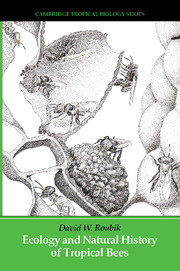2 - Foraging and pollination
Published online by Cambridge University Press: 04 August 2010
Summary
Resources gathered by bees
An understanding of bee ecology requires knowledge of the variety of resources they use to construct and defend their nests, maintain metabolism, and reproduce. These activities, crucial to reproductive fitness and survival, most certainly influenced the evolution of morphological, physiological, and behavioral traits. With few exceptions, both female bees and males gather food from flowers. In addition, except for those that usurp the nests of others, most bees gather nesting material and provisions for their larvae. The resource menu is a large one. Foraging bees normally seek plant products such as gums, resins, rotten wood, bark, fruit juices, seeds, leaves, plant hairs or trichomes, fragrances, pollen, nectar, oils, spores and rusts, sap, and the honeydew excreted by plant-feeding homopteran bugs and fungi, other natural products such as wax, animal feces, carrion, urine, and hairs, and combined plant and animal products such as cerumen (a mixture of resin and wax made by meliponine bees) and propolis (a similar mixture containing relatively little wax made by honeybees). Other substances used by bees include mud, loose soil, gravel, various salt solutions, and water. An overview of such materia prima gathered by bees is given here, followed by discussion of mechanisms of its collection.
Because so many different materials are employed, we scarcely know the degree to which the structural, biochemical, and behavioral traits of bees are suited to each.
- Type
- Chapter
- Information
- Ecology and Natural History of Tropical Bees , pp. 25 - 160Publisher: Cambridge University PressPrint publication year: 1989
- 2
- Cited by

